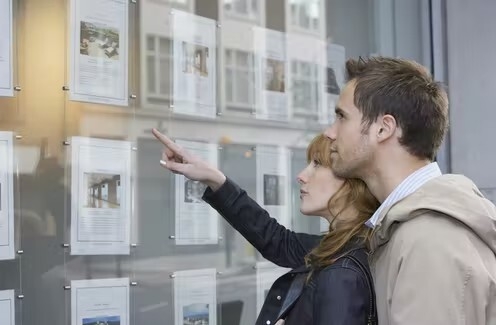You wouldn’t know it from the pages of our daily newspapers, but the rate of growth in rents has been pretty modest.
Not everywhere, not for everyone, but for most Australians who rent.
According to the most recent count used by the Bureau of Statistics to compile the consumer price index, rents increased by only 1.6% in the year to June.
By comparison, wages climbed 2.6%.
Higher increases in other prices pushed the overall consumer price index up 6.1%.
Rent decreases during COVID mean that over the past five years the total increase has been just 1.5%.
Average rents are barely any higher than they were at the start of COVID.
The Bureau gets its data direct from the computers of real estate agents, state housing authorities and the Department of Defence (for Darwin).
It covers rent actually paid, for a “matched sample” of dwellings, meaning it refers to the same dwellings each quarter so as to record genuine price changes.
Actual versus advertised rents
In contrast, the media (and some interest groups) prefer to focus on the data for “advertised” or asking rents. These have been growing more strongly than the overall mass of rents paid.
Nationwide, advertised rents climbed 8.2% in the year to June, and by almost 18% over the five years to June on CoreLogic’s data.
But advertised rents are only a tiny fraction of the rents actually paid. Not all properties get advertised. Advertised rents don’t always match up with the agreed rent. Most renters remain on existing contracts.
Although advertised rents might be expected to relate to overall rents over time, they are not necessarily representative of the entire market.
Our main concern ought to be what has happened to low-income renters.
Low increases for low-income renters
Australia’s lowest-income renters receive rent assistance, which is pretty frugal. Single renters get no more than $73 a week, and very large families up to $97.
But the typical rent paid by Australians on rent assistance hasn’t increased much. Over the year to June, the median rent for rent assistance recipients climbed by 1% – roughly $5 per week. Over the past five years it has increased 9% – somewhat less than the increase in the consumer price index of 10.7%.
Over the longer term, low-income rents have increased more sharply. Households in the bottom 40% of income distribution used to spend around 22% of their after-tax income on rent, and now spend about 30%, down from a peak of 32%.
If there is a crisis in rents, the figures suggest it is not widespread.
Rents in locations including Perth and Darwin are climbing much more strongly than others as they come off long periods of negative rent growth.
The growth in asking rents is most pronounced away from the cities, in particular in holiday and tree-change destinations such as Richmond-Tweed (including Byron Bay), Gold Coast, Sunshine Coast and Wide Bay.
Some were experiencing strong growth in asking rents before COVID, which accelerated through COVID.
Other regions, including parts of Sydney and Melbourne, have experienced subdued or negative growth.
Across all renting households we are yet to see any serious growth. To date, the “rent crisis” has been felt mainly in a few specific locations and among people looking for new rental properties.



 UK cities need greener new builds – and more of them
UK cities need greener new builds – and more of them  Stamp duty is holding us back from moving homes – we’ve worked out how much
Stamp duty is holding us back from moving homes – we’ve worked out how much  Debunking myths about community housing: What governments and the public should know
Debunking myths about community housing: What governments and the public should know  UBS "이 미국 도시, 부동산 거품 위험 가장 높아"
UBS "이 미국 도시, 부동산 거품 위험 가장 높아"  EU Delays Mercosur Free Trade Agreement Signing Amid Ukraine War Funding Talks
EU Delays Mercosur Free Trade Agreement Signing Amid Ukraine War Funding Talks  New Zealand Business Confidence Hits 30-Year High as Economic Outlook Improves
New Zealand Business Confidence Hits 30-Year High as Economic Outlook Improves  Hong Kong's Housing Market Slumps for Fifth Month: What’s Next?
Hong Kong's Housing Market Slumps for Fifth Month: What’s Next?  U.S. Dollar Steadies Near October Lows as Rate Cut Expectations Keep Markets on Edge
U.S. Dollar Steadies Near October Lows as Rate Cut Expectations Keep Markets on Edge  Oil Prices Climb on Venezuela Blockade, Russia Sanctions Fears, and Supply Risks
Oil Prices Climb on Venezuela Blockade, Russia Sanctions Fears, and Supply Risks  Singapore Growth Outlook Brightens for 2025 as Economists Flag AI and Geopolitical Risks
Singapore Growth Outlook Brightens for 2025 as Economists Flag AI and Geopolitical Risks  BoE Set to Cut Rates as UK Inflation Slows, but Further Easing Likely Limited
BoE Set to Cut Rates as UK Inflation Slows, but Further Easing Likely Limited  UK Housing Market Slows Amid Tax Hike Concerns
UK Housing Market Slows Amid Tax Hike Concerns  Asian Fund Managers Turn More Optimistic on Growth but Curb Equity Return Expectations: BofA Survey
Asian Fund Managers Turn More Optimistic on Growth but Curb Equity Return Expectations: BofA Survey  Japan Exports to U.S. Rebound in November as Tariff Impact Eases, Boosting BOJ Rate Hike Expectations
Japan Exports to U.S. Rebound in November as Tariff Impact Eases, Boosting BOJ Rate Hike Expectations  What should you do if you can’t pay your rent or mortgage?
What should you do if you can’t pay your rent or mortgage? 
































